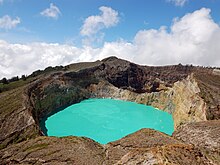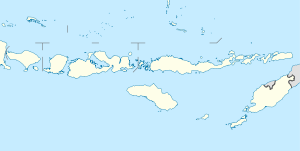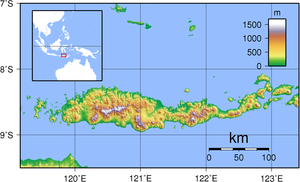Flores (Indonesia)
| Flores | ||
|---|---|---|
| The small town of Bajawa on Flores | ||
| Waters | Lake Flores , Lake Sawu | |
| Archipelago | Lesser Sunda Islands | |
| Geographical location | 8 ° 37 ′ S , 121 ° 8 ′ E | |
|
|
||
| length | 354 km | |
| width | 63 km | |
| surface | 15,175 km² | |
| Highest elevation |
Poco Mandasawu 2370 m |
|
| Residents | 1,831,000 121 inhabitants / km² |
|
| main place | Maumere | |
Flores ( Portuguese for "flowers"; also Floris; Indonesian Pulau Flores - Flores Island ) is one of the Small Sunda Islands .
The island is 15,175 km² and has 1,831,000 inhabitants (2010 census). Flores belongs to the Indonesian province of East Nusa Tenggara . About 91% of the population are Christians; most of them Catholics, a result of the Portuguese proselytizing in the 16th century.
geography

Flores is 354 km long. At its widest point, the island, which extends in a west-east direction, measures 63 km.
To the west of Flores are the small islands of Rinca and Komodo as well as the larger Sumbawa , south of Sumba and the Sawu Sea . In the east are the islands of Adonara and Solor , in the southeast Timor , in the north the Floresee with Sulawesi . About 18 kilometers off the north coast is the volcanic island of Palu'e .
The city Ende with 60,000 inhabitants is located on the south coast and is the most important ferry port in the direction of Timor-Barat ( West Timor ). A small airport is a few kilometers outside the city. East of Ende on the north coast is Maumere , the capital of the island, in the administrative district of Sikka with 70,000 inhabitants. The largest airport in Flores is located here. The capital of East Flores is Larantuka .
landscape
On the coast, Flores is characterized by lowlands with light tropical rainforest and savannah , while inland a highland with partly still active volcanoes rises to 2382 m . The most famous volcano is the 1639 m high Gunung Kelimutu . Its three crater lakes, separated only by high walls, change their colors at irregular intervals. In 1986 the colors were turquoise, dark green and black-red, in November 2006 the lakes shone in green, brown and black. What leads to the color change has not yet been clarified exactly, apparently the mineral release of the crater floors changes in phases.
The west coast of Flores is one of the few places outside Komodo Island where the Komodo dragon is found. The administrative authority for the "Waran Islands" Komodo and Rinca is located in Labuan Bajo, also on the west coast .
Administrative division
The island is divided into eight administrative districts ( Kabupaten divided): from west to east: Westmanggarai , Manggarai , Ostmanggarai , Ngada , Nagekeo , end , Sikka and Ostflores .
history
Like many other Sunda Islands , Flores was already settled by early representatives of the Hominini - probably Homo erectus ; stone tools found in the Soa basin , more than a million years old , speak for this . In September 2003 anthropologists discovered a fossil skeleton in a karst cave called Liang Bua , the first evidence of Homo floresiensis , which is also known as the " hobbit " because of its small size .
Flores may have belonged to the kingdom of Majapahit in the 13th century , then to the principality of Makassar .
In 1544 a Portuguese merchant ship sighted the eastern cape of the island and named it "Cabo das Flores" ( Cape of Flowers ). Around 1570 the first European seafarers and merchants settled on the island and christened the entire island “Flores”, although no more flowers grew here than in other parts of Indonesia.
Shortly before 1600, Portuguese merchants left Solor and settled in Larantuka . The merchants had fallen out with the Dominicans in Solor because they did not want to be harnessed for the Christianization there. In 1613 the Dutch captured the Portuguese fortress on Solor. The Portuguese moved their base to Larantuka, to the east of Flores. From Larantuka, the Topasse controlled the trade network in the region, especially the lucrative sandalwood trade from Timor . The topasses were descendants of Portuguese soldiers, sailors and traders who married women from Solor and Flores. The Larantuqueiros , as the Topasse called themselves, had developed into their own, relatively loose but powerful state, whose influence extended beyond the settlements. The core cell was formed by the "triple union" Larantuka, Wureh and Konga. In theory they were subordinate to Portugal, but in practice this state structure was independent. There were no Portuguese officials and no taxes were paid. Letters from the government in Lisbon were ignored. In Larantuka there was a bloody power struggle for years between the da Costa and da Hornay families, who eventually shared power.
From 1667, the Netherlands gradually occupied Flores. The last remnants of the Portuguese colony in the east of the island, such as Larantuka, were taken over by the Netherlands in 1861. As early as 1851, the Portuguese governor José Joaquim Lopes de Lima , without authorization from Lisbon , sold several areas on the Lesser Sunda Islands , which were under Portuguese sovereignty, to the Netherlands for 200,000 florins. Lisbon did not recognize the sale and had Lopes arrested. He died on the way back to Europe. From 1854 the agreements were renegotiated. The sale was finally confirmed in the Lisbon Treaty . The ratification took place in 1859. According to the treaty, the population could keep their Catholic faith. Up until Indonesia's independence, Flores was part of the Dutch East Indies , which was repeatedly shaken by rebellions. In 1911 and 1912 alone, there were ten armed uprisings against the Dutch.
The nationalist and later Indonesian President Sukarno was exiled to Flores by the Dutch after Ende in 1933. During the Second World War , the island was occupied by Japan from 1942 to 1945 .
population
languages
The districts of West Mangarai, Manggarai, East Manggarai, Ngada, Ende and Sikka are named after four well-known ethnic groups: Manggarai , Ngada , Ende and Sica . There are other ethnic groups and language groups such as the Lamaholot in the east (Flores Timur) and in between there are an abundance of small groups with different dialects such as Ende-Li'o , Nage , Ke'o. The larger ethnic groups have also developed regional cultural differences. Until the colonial era, the island was divided into small empires, some of whose rulers had received the title of Raja from the Dutch , but did not necessarily rule over a uniform society.
religion
The population of Flores, like that of the neighboring island of Timor to the south-east , is largely Catholic . The Archdiocese of Ende and the Diocese of Maumere are located on the island . There is a religious border within Indonesia to the predominantly Muslim island of Sumbawa to the west .
music
Traditional music on Flores is fragmented according to the ethnic structure, which is why Jaap Kunst , who conducted field research there in 1930, called the island a musicological paradise. In the west and in the center, three and four-part chants are part of the musical tradition, some are accompanied by drums or gongs . As elsewhere on the East Indonesian islands, bamboo zither (cf. the sasando on roti ) and bamboo slit drums ( toda ) are known. The nationwide widespread jaw harp genggong come in several bottle-shaped variants and are used for private entertainment. The indirectly blown bass flute foimere is unique. Songs are sung for the harvest, as a dance accompaniment and as laments for the dead. The only stringed instrument in the eastern part is the single-stringed robeke or mbeka (see rebab , name derived from the medieval European lute rebeke ), as well as a simple spar xylophone . Nocturnal chants are often performed in pantun measure. In some coastal towns, the melodies of Portuguese folk songs from the 17th century, which have long since disappeared in the country of origin, have survived.
Agriculture
Besides rice , corn , coffee , cocoa , cassava and sugar cane are also grown.
literature
- Stefan Dietrich: Colonialism and Mission on Flores (1900-1942). Klaus Renner, Hohenschäftlarn 1987, ISBN 978-3-924189-09-9
- Jaap Kunst: Music in Flores: A study of the vocal and instrumental music among the tribes living in Flores. Brill, Leiden 1942
Web links
Individual evidence
- ↑ History of Timor ( Memento of March 24, 2009 in the Internet Archive ) - Technical University of Lisbon (PDF file; 805 kB)
- ↑ Monika Schlicher: Portugal in East Timor. A critical examination of the Portuguese colonial history in East Timor from 1850 to 1912 . Abera, Hamburg 1996, ISBN 3-931567-08-7 , ( Abera Network Asia-Pacific 4), (also: Heidelberg, Univ., Diss., 1994).
- ^ Jaap Kunst: Music in Flores: A Study of the Vocal and Instrumental Music Among the Tribes Living in Flores. Brill, Leiden 1942, pp. 119f
- ↑ Father Heerkens SVD: Songs of Florinesen. Collection of 140 Florinese songs and 162 texts with translation from the language areas of the Lionese, Sikonese, Ngada's and Manggaraier. EJ Brill, Leiden / Cologne 1953
- ^ Jaap Kunst: Music and Dance in the Outer Provinces . In: Tropenmuseum, University of Amsterdam (ed.): Jaap Kunst. Indonesian music and dances. Traditional music and its interaction with the West. A compilation of articles (1934–1952) originally published in Dutch. Amsterdam 1994, p. 187




